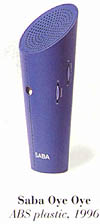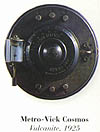Introduction Radios have been around, in some form or other, for just over a hundred years, but just what should a radio look like? The earliest radio
transmitters sent Morse code, not news or entertainment, but public interest grew, and interested amateurs began to build their own transmitters and receivers. The advent of broadcasting stations in the U.S. and Britain after World War I meant that millions of people could share the same radio experience.
wooden boxes with dials and brass terminals and very often the glowing valves perched on top. There were also large batteries, a separate horn loudspeaker or headphones, and a long wire antenna in the garden. The untidiness of the "wireless" began a trend to disguise radios as pieces of everyday furniture. The "smoker's cabinet" set is an early example, but radios also lurked in bookcases
and even armchairs. And from the mid-1920s, large and heavy suitcase-style portables were popular for picnics and motor trips. By the l 930s, a self-contained table set (often in a walnut cabinet) was the thing to have. Ornamental speaker grilles echoed the flowing lines of Art Nouveau, but generally, cabinets grew more simple during the 1930s. Bolder Art Deco styles from this period still recall the lost glamour of cinemas and ocean liners.
Set makers had started using "designers" to increase the appeal of their
and 1940s; his wooden cabinets were functional but still looked back to Arts and Crafts. Truly modernist designers were often architects first and foremost, inspired by Cubist art and the machine age. In Germany, the
Bauhaus art school was a focus for functional design and architecture.
The use of Bakelite and other plastics in the 1930s soon brought completely new and modern shapes. The Ekco company led the way in Britain, and the now famous "round" Ekcos seemed to hail a new and scientific era. Dark Bakelite vibrant jellybean colors of Catalin were used for many small American sets.
America tooled up for mass production earlier than most of Europe. In the 1930s the USA led the way in market research into what would make consumers buy. Famous names like Walter Dorwin Teague and Raymond Loewy worked in advertising or stage design before making their names as industrial designers, and their sleek "streamlined" styles for cars and airplanes soon spread to domestic appliances. Skyscrapers, too, provided a powerful image for American designers, as Harold van Doren's Air King radios show. Even the fantastic glitter of 1950s' American cars rubbed off on radio cabinets. People had
leisure time and money to spend, and as T.V. claimed the family's attention, the radio became more of a personal accessory. Set makers wooed women buyers with vanity-case and handbag styles. In the later 1950s German design was again influential. The clean simple lines of Dieter Rams' designs for Braun weren't a mass-market taste at the time, but the functional look, linked to Japanese technical know-how, led to a more or less international high-tech style by the 1970s. In Italy, too, the
1950s and 1960s saw a new confidence and belief in "the good life," reflected in the
Brionvega company's stylish radios and T.V.s. The transistor chip, born in the U.S.A. in the late 1940s, was cheap enough for the mass market by the late 1950s. By the start of the 1960s listening to pop on the "transistor" spelled teenage rebellion just as much as clothes and haircuts did.
pushed the simple radio into the background, though the style- conscious 1980s brought the "designer" gadget, and a niche market for matt black models. But by then the functional look was under assault from Post- Modern architects and critics; cult designers plundered past styles and came up with witty anything-goes objects. Today, clockwork and
solar-powered sets highlight green concerns, and those old radios, once thrown out as junk, are collectors' items. But they're not just beautiful objects; they give us a glimpse of who we were and how we lived. by David Attwood |

 In the
early 1920s, radios really were "sets" of
separate parts:
In the
early 1920s, radios really were "sets" of
separate parts:
 products. R.
D. Russell worked for Murphy in the 1930s
products. R.
D. Russell worked for Murphy in the 1930s
 gave way to other plastics in lighter
shades and the
gave way to other plastics in lighter
shades and the

 By the late 1970s, hi-fi systems and
cassette players had
By the late 1970s, hi-fi systems and
cassette players had